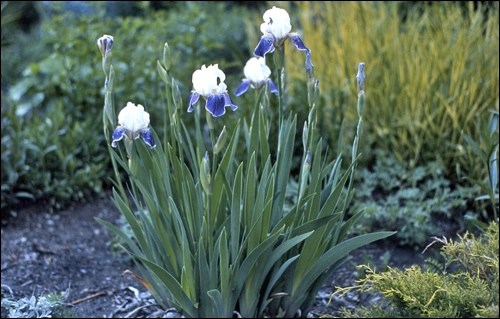I still have the white and purple bearded iris (Iris germanica) that I first grew more than 40 years ago, ‘Mrs Andrist.’ It was a gift from an older gardener down the back lane and would now be considered a “heritage plant” (hybridized in 1919). Dependable, hardy, tough and meant to last through the generations. Although native to the Mediterranean, bearded iris have graced prairie gardens almost since the time of European settlement. Prior to World War I, they appeared in several mail order catalogs serving Saskatchewan.
Iris were named after the Greek goddess of the rainbow, whose steps on earth were said to have left these flowers in all colours of the rainbow: white, yellow, greenish-yellow, orange, peach, red, pink, blue, purple, maroon and combinations thereof. They bloom in June for two to three weeks. The three erect upper petals (the “standards”) and the three lower drooping petals (the “falls”) can be of different colours. The fuzzy growth on the falls is called the “beard.” The grassy foliage is upright and sword-like, providing form and texture even when the plants are not in bloom. There are hundreds of varieties available. Heights range from six to 45 inches.
In terms of hardiness and drought-tolerance, not all bearded iris are created equal. Generally speaking, those classified as “dwarf” (often Iris pumila hybrids) or “intermediate” in height will be hardier on the prairies than those classified as “tall.” Read the fine print on the plant tag and look forward to keeping their company for years to come.
Bearded iris do best in full sun in well drained soil. Under shady conditions, they will bloom little. In heavy or wet soils, they are prone to rotting. Mulch the base of iris prior to their first winter to even out temperature fluctuations and provide a measure of insulation.
Divide them every four years in July by lifting the plant and gently pulling apart the rhizomes with attached “flags.” Those on the outside of the clump will usually be more robust that those towards the centre. Replant with the upper portion of the horizontal rhizome exposed.
Siberian iris (Iris sibirica), also blooming in June, are generally taller with narrower leaves. As their name suggests, they are native to Siberia (and many other parts of Europe) and are tough, long-lived and hardy. They grow best in full sun in organic, evenly moist soil. Cultivars include Ausable River, Butter and Sugar, Summer Sky, Caesar’s Brother and White Dove. There are many more.
Spuria iris (Iris spuria), sometimes called blue iris, are native to Iran and Turkey and were cultivated in England as early as 1573. They are 60 cm (24 in.) high with mostly yellow, peach, purple or blue flowers (which lack beards). Plant in full sun in well-drained moist soil. Among the many cultivars are Protégé, Adobe Sunset, Burnished Brass and Dutch Defiance.
Another species well worth seeking out is the milk iris (Iris lactea). Native to Asia, it is about 15 inches in height with pale blue flowers.
Iris are excellent in perennial borders, rock gardens, massed or for edging.
For more information about iris for the prairies, readers are cordially invited to a free lecture with Brian Porter on Wednesday, March 23 at 7:30 p.m. in the lower level of the Emmanuel Anglican Church, 607 Dufferin St. (at 12th Street), Saskatoon. Sponsored by the Saskatchewan Perennial Society.
Sara will be hosting a garden tour of England in May 2016. For more information contact Ruth at ruth@worldwideecotours.com or 888-778-2378.
This column is provided courtesy of the Saskatchewan Perennial Society (www.saskperennial.ca; hortscene@yahoo.com; NEW www.facebook.com/saskperennial). Check out our Bulletin Board or Calendar for upcoming garden information sessions, workshops and tours.



